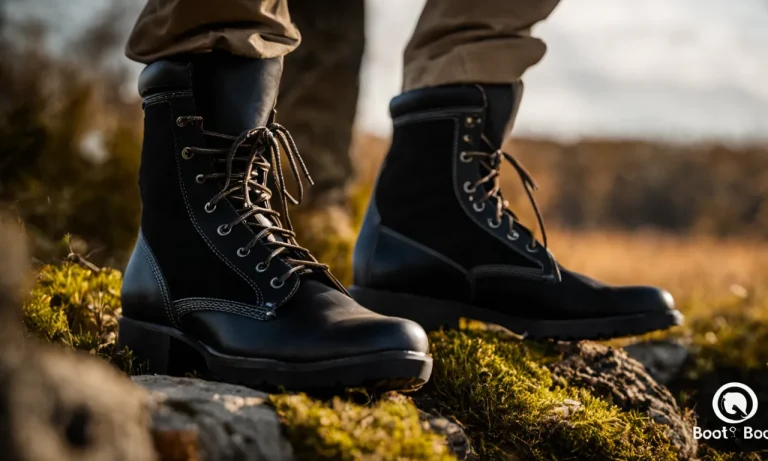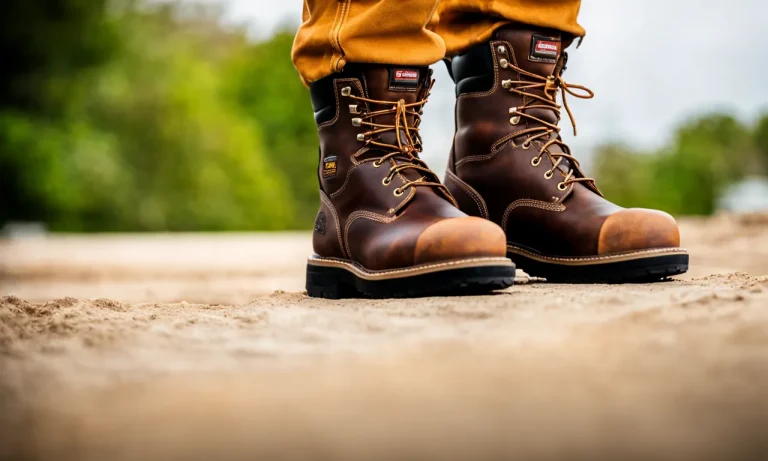Leather boots are a wardrobe staple that can last for years if properly cared for. Using the right products to clean and condition your leather boots is key to keeping them looking great. Coconut oil has grown in popularity as a natural moisturizer for skin and hair, leading some to wonder if it can also be used on leather boots.
If you’re short on time, here’s a quick answer: Coconut oil can be used on leather boots in small amounts, but it’s not necessarily the best leather conditioner. It may darken and discolor leather and does not offer the same level of protection and restoration as conditioners formulated specifically for leather.
Coconut Oil Benefits for Leather
Coconut oil is not only a versatile ingredient in the kitchen but also has numerous benefits for leather goods, including leather boots. Let’s explore some of the reasons why coconut oil can be an excellent choice for maintaining and caring for your leather boots.
Provides Temporary Moisture
One of the key benefits of using coconut oil on leather boots is that it provides temporary moisture to the leather. Leather can dry out over time, especially when exposed to harsh weather conditions or excessive heat.
Applying coconut oil can help to restore some of the lost moisture, preventing the leather from becoming brittle and prone to cracking.
Contains Vitamin E
Coconut oil is rich in vitamin E, which is known for its antioxidant properties. When applied to leather boots, the vitamin E in coconut oil helps to nourish and protect the leather from environmental damage. This can extend the lifespan of your boots and keep them looking great for longer.
Softens Stiff Leather
If you have a pair of leather boots that feel stiff or uncomfortable, coconut oil can come to the rescue. The oil has the ability to soften stiff leather, making it more pliable and comfortable to wear. Simply apply a small amount of coconut oil to the stiff areas and gently massage it in.
You’ll be amazed at how much of a difference it can make.
Gives a Subtle Sheen
Another advantage of using coconut oil on leather boots is that it gives them a subtle sheen. The oil can enhance the natural beauty of the leather, making it appear more polished and well-maintained. However, it’s important to note that excessive use of coconut oil can lead to a greasy or oily appearance, so it’s best to use it sparingly.
When using coconut oil on leather boots, it’s important to remember that a little goes a long way. Start by applying a small amount to a clean, soft cloth and gently rub it into the leather in circular motions.
Allow the boots to absorb the oil for a few hours or overnight before wiping off any excess. This will help to ensure that your leather boots reap the benefits of coconut oil without any unwanted residue.
While coconut oil can be beneficial for leather boots, it’s always a good idea to test it on a small, inconspicuous area first to ensure that it doesn’t cause any adverse effects. Additionally, it’s important to regularly clean and condition your leather boots to maintain their longevity and appearance.
For more information on caring for leather boots, you can visit websites such as Leather Care Supply or Shoe Abuse.
Potential Drawbacks of Using Coconut Oil on Leather
May Darken or Discolor the Leather Over Time
While coconut oil is often praised for its moisturizing properties, it may not be the best choice for leather boots. One of the potential drawbacks of using coconut oil on leather is that it can darken or discolor the material over time.
Leather is a natural material that can absorb oils, and coconut oil is no exception. As the oil penetrates the leather, it can alter its original color, leading to a noticeable change in appearance. This is especially true for lighter-colored leather boots.
Does Not Offer Deep Conditioning
Another drawback of using coconut oil on leather boots is that it does not offer deep conditioning. Leather, just like our skin, requires regular conditioning to maintain its softness, suppleness, and durability.
While coconut oil can provide some moisture to the leather, it may not penetrate deep enough to provide the necessary nourishment. Over time, this can result in dryness and stiffness, compromising the overall quality and longevity of the boots.
Can Leave Residue That Attracts Dirt
When using coconut oil on leather boots, it’s important to be mindful of the potential residue it can leave behind. Coconut oil has a tendency to solidify at lower temperatures, and when applied to leather, it can leave a greasy or oily residue.
This residue not only attracts dirt and dust, but it can also be challenging to remove. As a result, your boots may end up looking dirtier and require more frequent cleaning than if you had used a leather-specific conditioner or cleaner.
It’s worth mentioning that these potential drawbacks can vary depending on the type and quality of the leather, as well as the specific coconut oil used. If you’re unsure about using coconut oil on your leather boots, it’s always best to consult the manufacturer’s recommendations or seek advice from a professional leather care expert.
How to Apply Coconut Oil to Leather Boots
Coconut oil can be a great natural alternative for conditioning and moisturizing leather boots. Here is a step-by-step guide on how to apply coconut oil to your leather boots:
Clean Boots First
Before applying coconut oil, it’s important to clean your leather boots thoroughly. Use a soft brush or damp cloth to remove any dirt or dust from the surface. This will ensure that the coconut oil can penetrate the leather effectively.
Rub in a Thin Layer
Take a small amount of coconut oil and rub it between your hands to warm it up. Then, gently massage the oil onto the boots in circular motions. Make sure to apply a thin and even layer, covering the entire surface of the boots.
Remove Excess Oil
After applying the coconut oil, use a clean cloth to remove any excess oil from the boots. This step is crucial to prevent your boots from becoming greasy or attracting more dirt. Be thorough but gentle in removing the excess oil.
Let Absorb and Dry Overnight
Once you have applied the coconut oil and removed the excess, allow your leather boots to absorb the oil overnight. Place them in a well-ventilated area and let them dry naturally. By giving the oil enough time to penetrate the leather, you’ll ensure that your boots receive maximum conditioning benefits.
It’s important to note that while coconut oil can be beneficial for conditioning leather boots, it may not be suitable for all types of leather. It’s always a good idea to test the oil on a small, inconspicuous area of your boots first to ensure compatibility and avoid any unwanted effects.
For more detailed information on caring for leather boots and other leather products, you can visit www.leathercaredirect.com or www.shoecaresupplies.com.
Better Alternatives for Leather Boot Care
Leather Conditioners and Creams
When it comes to taking care of your leather boots, using leather conditioners and creams is a tried and true method. These products are specially formulated to nourish and moisturize the leather, keeping it supple and preventing cracks and dryness.
Leather conditioners and creams also help to restore the natural oils in the leather, prolonging its lifespan.
There are a variety of leather conditioners and creams available on the market, so it’s important to choose one that is specifically designed for boots. Look for products that are made with high-quality ingredients and have positive customer reviews.
Apply the conditioner or cream to your boots regularly, following the instructions on the product.
Mink Oil
Mink oil is another excellent option for maintaining the quality of your leather boots. Mink oil is known for its ability to penetrate deep into the leather, providing long-lasting protection and hydration.
It helps to soften the leather and keep it flexible, preventing it from becoming stiff and uncomfortable.
To use mink oil on your boots, first, clean them thoroughly with a soft cloth or brush. Then, apply a small amount of mink oil to a clean cloth and rub it into the leather in a circular motion. Allow the boots to dry naturally, and then buff them with a soft cloth to remove any excess oil.
Regular application of mink oil will keep your leather boots looking great for years to come.
Beeswax Based Products
Beeswax based products are another fantastic option for caring for your leather boots. Beeswax is a natural ingredient that helps to condition and protect the leather, while also providing a water-resistant barrier. This can be particularly beneficial if you live in a wet or snowy climate.
There are a variety of beeswax based products available, such as leather balms and waterproofing sprays. These products can help to prevent water damage, stains, and scuffs, while also keeping the leather soft and supple.
Apply the beeswax based product to your boots according to the instructions on the packaging, and enjoy the added protection and shine.
When it comes to taking care of your leather boots, using the right products is essential. Leather conditioners and creams, mink oil, and beeswax based products are all great alternatives to coconut oil for leather boot care.
These options will help to keep your boots looking and feeling their best, ensuring that they last for years to come.
Tips for Keeping Leather Boots in Great Shape
Store Properly When Not Worn
Proper storage is crucial for maintaining the quality and longevity of your leather boots. When not wearing them, it’s best to store them in a cool and dry place, away from direct sunlight. Avoid placing them near heat sources like radiators or fireplaces, as this can cause the leather to dry out and crack.
Consider using a shoe bag or box to protect them from dust and other potential damage.
Weatherproof Before Wearing in Rain or Snow
Leather boots are not inherently waterproof, so it’s important to weatherproof them before stepping out in rainy or snowy conditions. There are various products available specifically designed for this purpose, such as waterproof sprays or creams.
These products create a barrier that helps repel water and prevent it from seeping into the leather. Remember to follow the instructions provided by the manufacturer for the best results.
Use Cedar Shoe Trees to Maintain Shape
To keep your leather boots looking their best and maintaining their shape, consider investing in cedar shoe trees. These shoe inserts not only help retain the boot’s shape but also absorb moisture and odors.
Cedar is known for its moisture-wicking properties and its ability to prevent the growth of bacteria and fungi. By using cedar shoe trees regularly, you’ll ensure that your boots stay in great condition for years to come.
Clean Gently and Apply Conditioner Regularly
Regular cleaning and conditioning are essential for preserving the appearance and flexibility of leather boots. When cleaning, use a soft cloth or brush to remove any dirt or dust. Avoid using harsh chemicals or abrasive materials that could damage the leather.
Once clean, apply a leather conditioner to keep the leather supple and moisturized. This will prevent cracking and extend the lifespan of your boots. Be sure to follow the instructions on the conditioner product for best results.
Conclusion
Coconut oil can provide some moisturizing benefits for leather boots and is safe to use in small amounts. However, it’s not necessarily the ideal leather conditioner. Products specifically formulated for leather offer deeper conditioning, protection and restoration without the drawbacks of discoloration that coconut oil can cause.
By properly cleaning, conditioning, weatherproofing and storing your leather boots, you can keep them looking great for many seasons.
Taking the time to care for your leather boots pays off with many more years of wear. With the right conditioner and care regimen, your leather boots will become a comfortable, stylish fixture of your wardrobe.






